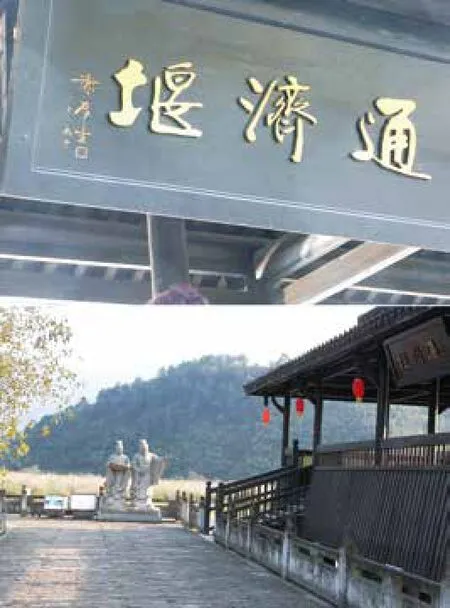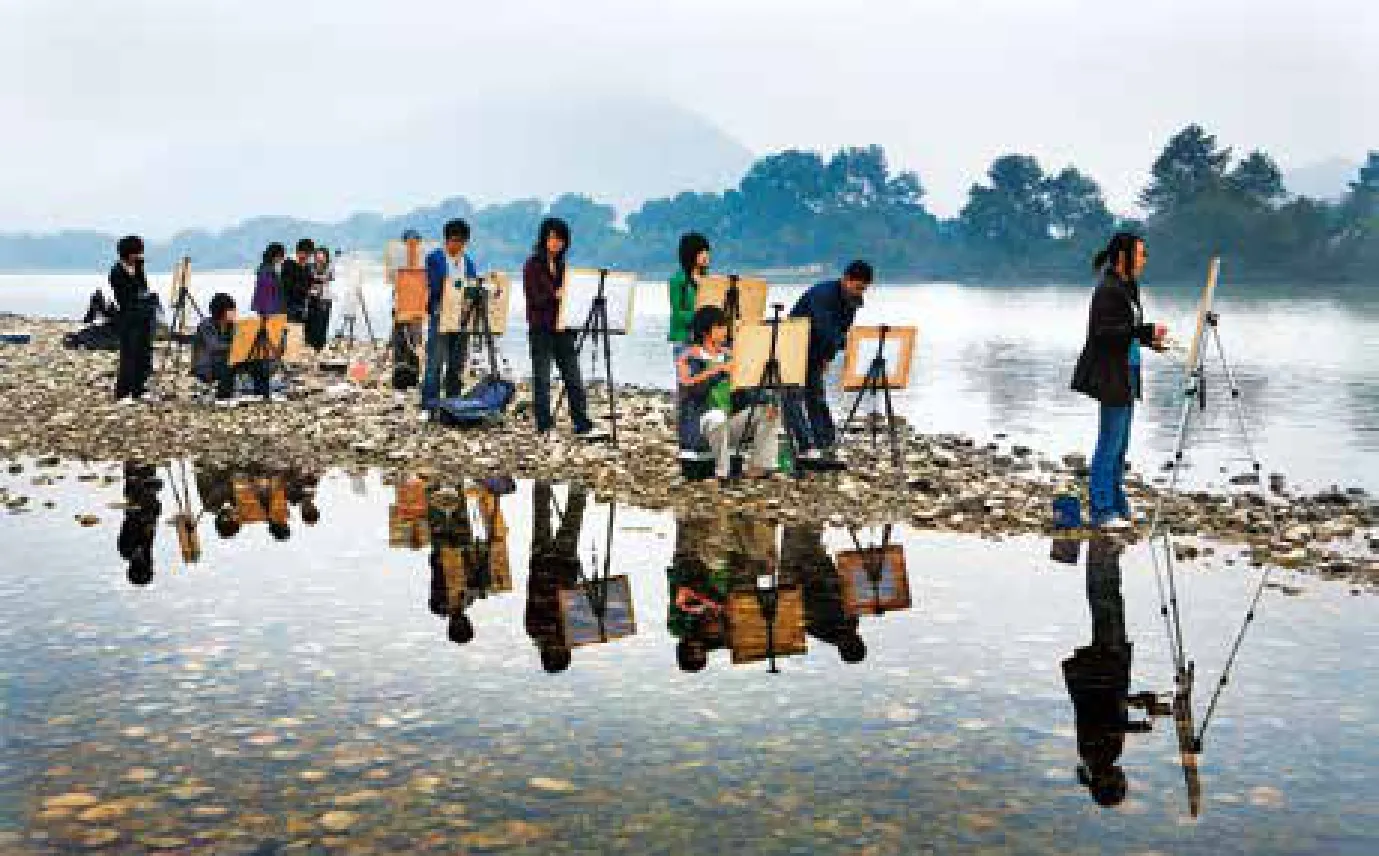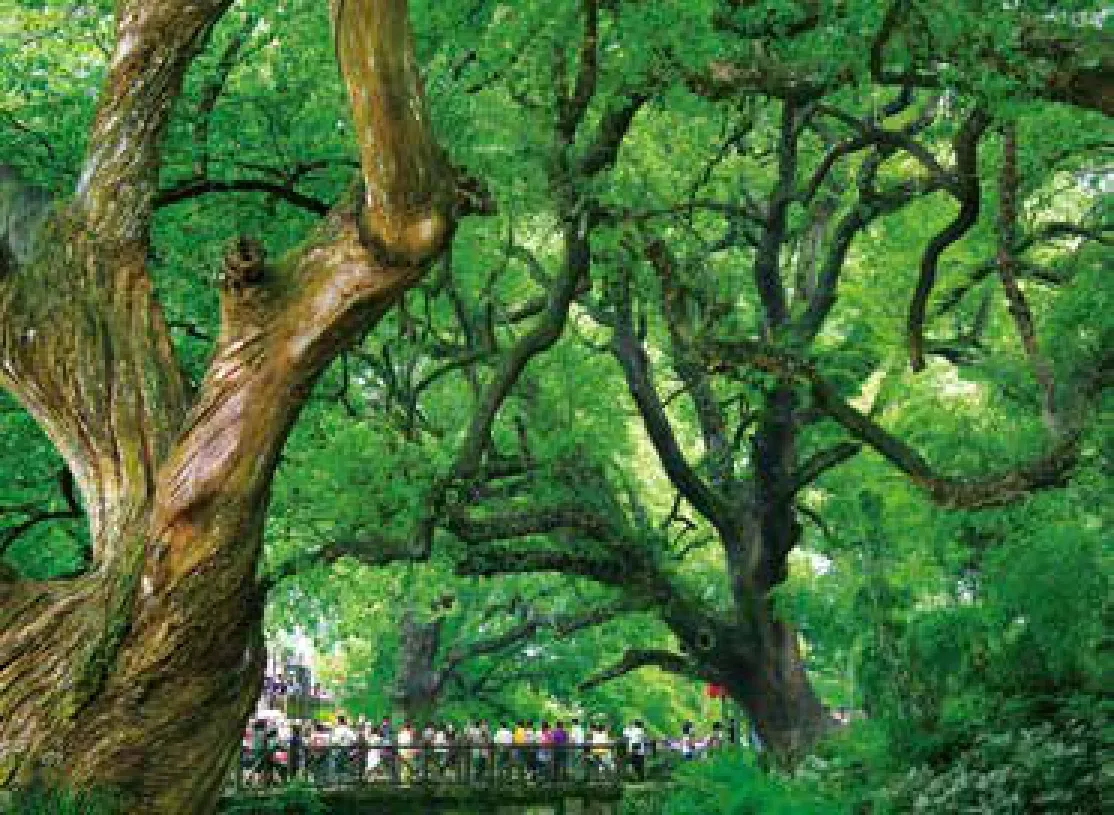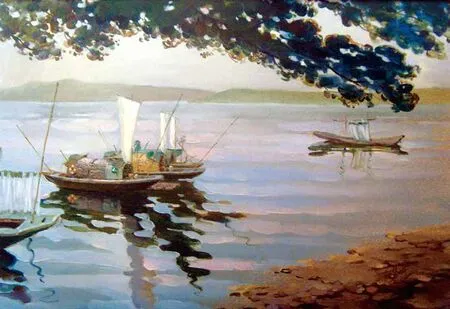古堰画乡:绿水青山间的画中小镇
●栗 子
古堰画乡:绿水青山间的画中小镇
●栗 子

滨江油画一条街This riverside street in the tourism zone is home to oil painting studios and galleries.
古堰画乡位于浙江省丽水市莲都区境内,区域内历史人文底蕴深厚,这里有建于公元505年的世界灌溉工程遗产、国家文物保护单位通济堰,它与千年古镇、千年石函、千年古碑刻群、千年古窑、千年双龙庙会、千年古樟树群、千年古墓群等人文胜景,共同展示给世人以独特而厚重的历史遗产。
贯穿古堰画乡的浙江省第二大河瓯江,景色秀美,生态环境优良,瓯江帆影与两岸青山、古街古村相掩映,极富江南水乡韵味。
深厚的历史人文和秀丽的自然山水,也吸引了各类艺术家在此描述对美的追求。自十九世纪六十年代,古堰画乡就有大批的画家和摄影家在此写生和创作。这里也由此成为国内著名的“丽水巴比松”画派的发祥地,中国摄影之乡和国际摄影节的主要创作基地。
走进古堰画乡,迎面一棵千年古樟树,枝桠伸展到瓯江边,像一把撑开的巨伞屹立着。古树下,是来自全国各地的游客和采风、写生的人群。近年来,来自全国各地的创客在古堰画乡投资主题民宿、文化创意等产业,宁静的古堰画乡因此而焕发出时代的乡村魅力。
创意乐园:生态与艺术碰撞出火花
古樟、码头、老街、画室,走进画乡,时间老人仿佛放慢了脚步,一切显得如此的惬意和恬静。画乡一条街—江滨古街,已有100多年的历史,临水而建,一直保持着明清的建筑风格,是画乡的核心区域。徜徉在古街上,你会发现无论墙上、变电箱或是空调外机上都挥洒有“创意”的3D油画;画室、画廊、奶茶店、布鞋行慵懒地“躺着”,与古街的氛围相得益彰。
2006年,丽水职业技术学院老师雷建华在溪边开了一家“古处画廊”,近十年里,雷建华不忘提升艺术水准,到北京进修期间,把浙南的草垛、天空、古宅搬进798的画廊。进修后回家乡授课,不时带学生返回小镇写生,和以前一样,自带板凳,一画就是一天。
刚从意大利游学回来的郑宝英毕业于缙云工艺美术学校,是个自由画家,3年前来到古堰画乡,就爱上了这里的山山水水。“在这里能找到艺术的灵感。”郑宝英说。如今,她已在古堰画乡安了家。随着生活的深入,丽水的巴比松油画与人结合得更为紧密,把丽水的乡土人情也描绘得更为淋漓尽致。
古堰画乡是八百里瓯江最瑰丽的河段,在这里,有的是帆影重重、船桨声声的悠闲时光,而一年四季、手执画笔分散在各个角落的画家们又为古堰画乡增添了一抹浓重的人文气息。截至2014年,景区已有各类艺术业态97家。其中,油画企业71家;国画16家、钢笔画3家、艺术展览馆6家、博物馆1家,巴比松画派群体发展到280余人。
这里已经成为国内著名的油画写生创作基地,包括中国美院、中央美院等全国300余家艺术院校在此建立了教学实践基地,每年前来写生创作的画家和学生超过12万人次,接待规模和接待层次位居全国前列。2015年“丽水巴比松”画派远赴法国,与法国巴比松画派进行了深入的学术交流,成为中国油画界首个与法国巴比松建立友好关系的画派。
画中古堰,梦中老街。如今,随着画家行、3D展、夜游季等一系列活动的推出,古堰画乡这幅“老”画换上了新景,在瓯江边焕然新生。
走在古街,不时会被一些新的文化艺苑所惊艳。在“添艺画苑”,画师雷发荣正聚精会神地在一片香樟木板上作油画,满屋散发着香樟树和油画的香味。雷发荣说,把香樟树锯成片,稍加清洗、打磨后,就可变成“画布”,用来作画。40岁的雷发荣将丽水本土风光画在具有浓郁乡土、生态特色的香樟木板上,形成了独具特色的香樟油画,受到游客欢迎,画苑生意不错。
而这样的创意在秀山丽水的古堰画乡比比皆是。怪不得有人说,古堰画乡是一幅行进中的乡土中国缩影、一份“绿水青山就是金山银山”的发展标本、一个有故事的浙南小镇。

通济堰Tongji Dyke, built in 505AD, a national cultural relic
创客天堂:文化与旅游比翼齐飞
在古堰画乡有一家叫“芷有一间”的茶室,可以在山环水绕间坐看岫壑浮云,很有味道。店如其名,茶室为主,民宿为辅,店内只有一间客房。老板吴仲银是江苏无锡人,曾经是位资深的旅游记者。他走遍大江南北,来到丽水后,发现这里的宁静秀美让人流连忘返。
新开的民宿“画中游”也很吸引眼球,门厅上一块艺术造型的门牌令人惊艳。“光是这块门牌就花了几万元。”老板陈金仁是一位画家,10多年前来到古堰画乡,3年前开始从事民宿经营。陈金仁的身份也从古堰画乡油画协会会长,变成了古堰画乡旅游行业协会副会长。

瓯江边上的写生者 陈拥军 摄By the Ou River, a photo by Chen Yongjun
“文化与旅游产业有很多方面其实是相通的。”在陈金仁的店里,老式楼梯、书架、草帘、水车,处处可以感受到文化的魅力。游客可以在这里喝茶聊天,体验农家慢生活,还可以摄影作画。
“古堰画乡”以堰闻名、以画为魂、以生态为根,融山水风光和历史文化于一体。历经十年发展,通过4A级景区和特色小镇的创建,这里已逐渐成为创客们大展宏图的舞台。
特别是2015年,古堰画乡成功入选浙江省首批37个特色小镇,同时跻身浙江省首批3个“服务业特色小镇”创新试点行列,新一轮发展迎来重大机遇。2015年上半年,接待人次同比递增23.6%,营业收入同比递增40%。
据当地相关负责人介绍,下一步,通过文化创意产业基地、江滨创意街区、创业创客基地、通济堰养生园、“隐居画乡”高端民宿、“玩摄影”营地、5D梦幻油画馆和酒吧一条街等一系列项目的陆续建设,这里将逐步形成绘画艺术、休闲旅游、美术教育、文化电商、景观农业等五大产业板块,进一步优化创新创业环境。
“隐居画乡”是古堰画乡管委会为了进一步提升景区民宿建设水平,而积极引进的“招牌”项目。该项目于2015年引入,由浙江隐居集团负责投资。“隐居画乡”作为当前古堰画乡景区最高端的民宿,是一个集酒店、度假、文化等元素为一体的度假生活平台,进一步提升了古堰画乡整体接待水平和文化品位,对当地民宿的特色化建设起到了引领示范和带动作用。
文化是创新创业的灵魂,古堰画乡高度重视历史文化的挖掘保护,以及对创新创业文化的培育引领。按照“理念创新、文旅并重、跨界思维”的视角,建立了以“巴比松油画”文化为核心,千年港埠文化、千年古堰文化等为辅的多元文化体系。并按照艺术小镇、旅游小镇和创业小镇“三镇合一”的理念,打造特色小镇和乡村旅游创客基地,吸引了一批创意画坊、青瓷工艺、手工竹编等文化创意项目入驻,进一步丰富了文化旅游业态。目前,中国文旅创联已计划在景区建设创客基地,浙江凯恩集团也已计划建立古堰画乡创客基金,为下一步规模引进创客资源奠定基础。
古堰画乡建设管委会相关负责人表示,通过对传统农耕水利文化的挖掘传承和弘扬,培育以油画为主导的文化产业链和休闲度假旅游产业链,在未来三年,古堰画乡风情小镇将完成总投资51.91亿元,打造成为长三角地区知名的综合型文化旅游目的地。
A Paradise for Oil-Painters and Cultural Innovators
By Li Zi
Guyan Huaxiang (Ancient Dyke and Land of Painting) is a tourism zone with Dagangtou Town as its core in Lishui, a region traversed by the Ou River, the second largest river in Zhejiang. Boasting an inviting Jiangnan ‘water town’ vista, the zone has drawn in painting artists and photographers from all over the country since the 1980s, and is widely recognized as the birthplace of the ‘Barbizon school’ of China and a key rendezvous for photography enthusiasts and professionals from all over the world. The development of the zone in recent years features strong entrepreneurial flavors contributed by cultural innovators coming from all over the country.

千年古樟迎远客 王建平 摄Ancient Camphor Trees Welcome Visitors from Afar, a photo by Wang Jianping
A ready source of inspiration for oil-painting artists
Time seems to have frozen up in the pleasant serenity of the zone. The zone is composed of small ancient villages, ancient ceramic kilns, huge camphor trees, in addition to the Tongji Dyke built in 505 AD, a key cultural relic under the protection of the national government. With a history of over 100 years, the riverside street in the town is flanked by Ming and Qing-style architecture. Oil painting creations can be seen everywhere. Even the box covers of the town’s transformer stations are decorated with 3D oil-painting works.
Over the past decade, the zone has been a sketch destination frequented by Lei Jianhua, an art teacher from a local vocational school and the owner of the first oil-painting studio in the zone. He and his students would bring stools and spend a whole day here, indulging in the enchant-ing scenery and practicing painting from real life.
Coming back from her study in Italy, freelance painter Zheng Baoying fell in love with the picturesque town when she found this place three years ago. She settled down for a peaceful life as well as new inspiration for her artistic pursuits.
The zone has the most picturesque part of the Ou River within its territory. The mesmerizing seasonal beauty of the river has nurtured a robust Barbizon artist community that is now served by six art galleries, one museum, seventy-one oil-painting companies, and nineteen enterprises specializing in traditional Chinese painting and pen drawing. The zone also serves as a key teaching base for more than 300 art schools in China, including such prestigious institutions as China Art Academy and the Central Academy of Fine Arts. In 2015, the Barbizon artists based in the zone talked with the French Barbizon artists in a seminar held in France, making the Barbizon artists of Lishui the first oil-painting community in China to shake hands with the French counterparts.

瓯江之舟(油画) 胡苏丽 作 Boats on the Ou River, oil painting by Hu Suli
A paradise for cultural innovators
The town is the new home of Wu Zhongyin, formerly a senior journalist and travel writer. Fascinated by the tranquility and exquisite beauty of Lishui and the unique artsy atmosphere of the ancient zone, he settled down to run a teahouse which he named ‘The Only One’ and truly has only one guestroom.
One of the homestay places in the town is run by Chen Jinren, who came here about 10 years ago. The man launched his business three years ago. Formerly a member of the zone’s Oil-painting Artists Association, Chen is now the deputy chair of the local Tourism Association.
In 2015, the oil-painting town became one of the 37 ‘charming towns in Zhejiang’.
Future development of the painting zone, based on the launch of a series of high-end projects including a photography camping site, a 5D oil-painting studio and a bar street, will bring the quality of the entrepreneurial environment to a new level. The zone has also caught the eye of China Cultural International Tours and Zhejiang Kan Group, both having announced investment plans to launch an entrepreneurial base in the town. A total of about 5 billion yuan will be put into a three-year development scheme that aims to build the town into a coveted cultural tourism destination in the Yangtze River Delta region of China.

